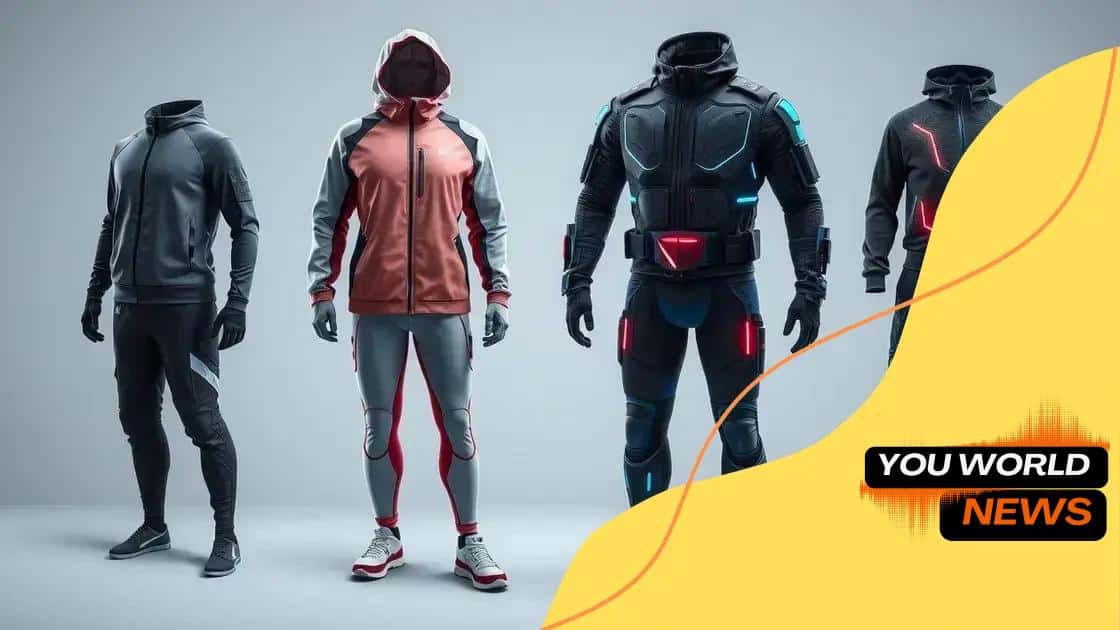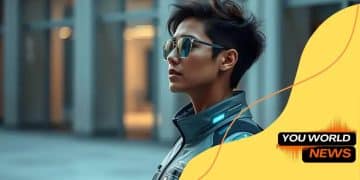Tech-infused fabrics transforming modern fashion

Tech-infused fabrics are innovative textiles that combine advanced technology with fashion, offering benefits like functionality, sustainability, and personalization to transform modern clothing.
Tech-infused fabrics transforming modern fashion are setting the stage for a revolution in what we wear. Imagine clothing that not only looks good but also adapts to your needs and environment. Curious about how this blend of style and technology can change your wardrobe? Let’s dive in!
Understanding tech-infused fabrics
Understanding tech-infused fabrics is essential as they revolutionize the fashion industry. These innovative materials combine traditional textiles with cutting-edge technology, offering remarkable benefits.
What Are Tech-infused Fabrics?
Tech-infused fabrics are textiles that have been enhanced with technological features. This means they can do more than just cover our bodies; they can provide functions like moisture-wicking, temperature regulation, and even self-cleaning properties.
Benefits of Tech-infused Fabrics
Let’s explore some of the advantages:
- Comfort: Many tech fabrics improve comfort through breathability and flexibility.
- Functionality: They can offer features that enhance performance, making them ideal for activewear.
- Sustainability: Some are made from recycled materials and can reduce waste in the fashion industry.
- Durability: Tech-infused fabrics often last longer than traditional materials, standing up to wear and tear.
The application of tech-infused fabrics extends beyond just sportswear. High-end designers are integrating these materials into everyday fashion too. Imagine wearing clothes that can change colors based on your environment or ones that charge your electronic devices. These ideas sound like science fiction, but they are becoming reality!
As the demand for functionality in fashion rises, more brands are investing in technology to keep up with consumer preferences. This exciting trend not only transforms the way we dress but also pushes the boundaries of creativity in the industry.
Examples of Tech-integrated Clothing
From smart jackets that monitor your heart rate to pants that keep you warm in cold weather, the possibilities are endless. Early adopters of tech-infused fabrics set the stage for future innovations.
In essence, understanding tech-infused fabrics unveils a world of potential in fashion that blends technology and style seamlessly. As we adapt to this ever-evolving landscape, fashion will never be the same again. Stay tuned for more innovative transformations ahead!
Benefits of incorporating technology in fashion
The benefits of incorporating technology in fashion are vast and impactful. As designers and brands embrace new technologies, they create clothing that enhances both function and style.
Enhanced Performance
One significant advantage is the enhanced performance of tech-infused fabrics. These materials can adapt to the wearer’s needs, making them ideal for active lifestyles. For instance, some clothes can wick away moisture, keeping you dry during workouts.
Sustainability
Incorporating technology also contributes to sustainability in fashion. Many tech fabrics are made from recycled materials, which helps reduce waste. Using these innovative methods can lessen the environmental impact of clothing production.
Technology in fashion can also mean smarter designs, like garments that change temperature based on the weather. This adaptability ensures comfort and increases wearability. With smart textiles, a single piece can serve multiple purposes. This reduces the need for excess clothing, promoting a more sustainable approach to fashion.
Customization and Personalization
Another notable benefit is customization. Technology allows consumers to choose styles that fit their unique preferences. For example, wearable tech, like fitness trackers embedded in clothing, caters to individual needs. Customers can wear clothes that reflect their lifestyle while still looking fashionable.
Moreover, incorporating technology enhances the overall user experience. Interactive features, such as touch controls on clothing, create a new level of engagement between the consumer and the garment. This integration transforms traditional clothing into innovative, functional pieces.
Improved Durability
Lastly, tech-infused fabrics are often more durable than conventional textiles. They resist wear and tear, giving garments a longer life span. Investing in such clothing can save money in the long run as they require less frequent replacement.
Embracing technology in fashion is not just a trend; it represents a significant evolution in how we define style and function. The incorporation of these advancements can lead to transformative changes in our wardrobes, making them smarter and more sustainable.
Innovative examples in modern clothing

Innovative examples in modern clothing showcase how technology and fashion can blend seamlessly. Designers across the globe are experimenting with materials and functionalities that redefine what we wear.
Smart Athletic Wear
Many sports brands now offer athletic wear that tracks performance. For instance, shirts and leggings come with built-in sensors that measure data such as heart rate and calories burned. This integration allows athletes to optimize their workouts and push their limits.
Adaptive Clothing
Another exciting trend is adaptive clothing designed for individuals with disabilities. These garments feature easy-to-use fastenings and adjustable fits, making dressing more accessible. Many brands focus on creating stylish options that are functional and inclusive.
One prime example of innovation in fashion is the use of phase-changing materials. These materials can absorb, store, and release heat, providing comfort in various temperatures. Imagine a jacket that adjusts its warmth based on the weather outside – this is the future of clothing!
Fashion and Wearable Technology
Wearable technology has also taken center stage. Accessories like smartwatches and fitness trackers are now designed to complement outfits rather than stand out. Fashion-forward users can now find tech that aligns with personal style.
On top of that, there are garments with embedded LED lights, allowing wearers to create their own patterns and colors. This customization turns clothing into a canvas for self-expression, merging art and fashion in a dynamic way.
Eco-friendly Innovations
Lastly, we see eco-friendly fabric innovations making waves. Brands are developing textiles from organic materials like recycled plastic bottles. This not only reduces waste but also creates stylish, sustainable products that appeal to environmentally conscious consumers.
These innovative examples in modern clothing illustrate just how versatile and functional fashion has become. As designers continue to push boundaries, we can look forward to an exciting future where technology enhances our everyday wear.
The future of smart textiles
The future of smart textiles is bright and full of possibilities. With rapid advancements in technology, we are witnessing the evolution of fabrics that not only serve as clothing but also perform multiple functions.
Integration of Advanced Technologies
Smart textiles are increasingly integrating advanced technologies. This integration allows fabrics to respond dynamically to various stimuli. For instance, researchers are working on materials that can monitor biometrics like heart rate or body temperature. Imagine a shirt that gives real-time feedback about your health!
Fashion Meets Functionality
As we move forward, fashion continues to merge with technology. Designers are creating garments that enhance our daily lives. Some clothes can even charge electronic devices. This is an exciting crossover that allows clothing to be both fashionable and functional.
One innovative area is the development of fabrics that can change color or pattern using embedded sensors. These garments will not only allow personal expression but also adapt to different occasions. Your dress could switch from a professional look to something casual at the touch of a button!
Environmental Impact
The future of smart textiles also holds promises for sustainability. Eco-friendly materials are being used to create high-tech fabrics, supporting the reduction of textile waste. Such innovation is crucial in an era where environmental concerns are at the forefront.
As the fashion industry continues to evolve, we can expect more brands to focus on sustainable practices while integrating smart technologies. This will set a new standard for what clothing can be.
Personalization and Customization
Another exciting trend is the rise of personalization in smart textiles. Consumers will have the ability to customize clothing to fit their preferences. With technologies like 3D printing, unique designs will be more accessible than ever.
The future may also bring tailor-made solutions for clothing based on individual needs and preferences, making every piece truly unique to the wearer. The possibilities in the realm of smart textiles are endless!
Challenges in the tech and fashion industry
The challenges in the tech and fashion industry are significant and complex. As these two fields merge, various obstacles arise that both consumers and creators must navigate.
Technology Integration
One major challenge is the integration of technology into traditional fashion. Many designers are not tech-savvy, making it difficult for them to adopt new tools. This hesitation can result in missed opportunities to innovate.
High Costs of Development
Another notable obstacle is the high cost of developing smart textiles. Research and production can be expensive, which may deter small brands from investing in these advancements. As a result, only larger companies may dominate the market.
- High development costs limit accessibility for small businesses.
- Expensive technology can lead to higher retail prices.
- Brands with more resources may overshadow lesser-known designers.
Moreover, the rapid pace of technological advancement can overwhelm some companies. Staying updated with the latest technology requires constant learning and adaptation. This can be challenging for businesses that are already stretched thin with existing operations.
Consumer Awareness
Consumer awareness also presents a hurdle. Many people are unaware of the benefits of smart textiles and may be skeptical about their effectiveness. Educating the public is necessary for the widespread adoption of tech-infused garments.
Additionally, there are sustainability concerns tied to the production of these innovative fabrics. While tech can provide eco-friendly solutions, it can also lead to increased waste if not managed properly. Companies must balance innovation with sustainable practices to avoid contributing to environmental issues.
Data Privacy Issues
Lastly, data privacy is a critical challenge as we embrace wearable technology. Many smart fabrics collect personal data, raising concerns about how this information is used and stored. Ensuring user privacy is essential for consumer trust.
Addressing these challenges in the tech and fashion industry will require collaboration, education, and a commitment to innovation. Only by tackling these obstacles can we ensure a future where technology enhances our fashion choices without compromising quality or ethics.
In conclusion, the fusion of technology and fashion is creating a new era of possibilities. As seen through smart textiles and innovative designs, clothing is becoming more than just something to wear. It now offers enhanced functionality, sustainability, and personalization. However, there are challenges to address, such as integrating new technologies and ensuring consumer trust. By overcoming these obstacles, the fashion industry can pave the way for a brighter, more innovative future that embraces both style and technology.
FAQ – Frequently Asked Questions about Tech-infused Fabrics in Fashion
What are tech-infused fabrics?
Tech-infused fabrics are textiles enhanced with technology, offering features like moisture-wicking, temperature regulation, and even health monitoring capabilities.
How do smart textiles benefit consumers?
Smart textiles provide enhanced functionality, sustainability, and personalization, allowing consumers to enjoy clothing that adapts to their needs and preferences.
What challenges do brands face in adopting tech in fashion?
Brands face challenges such as high development costs, integration complexities, and the need for consumer education about the benefits of smart textiles.
Are smart textiles sustainable?
Many smart textiles are produced with eco-friendly materials and practices, aiming to reduce waste and environmental impact while offering innovative solutions.





